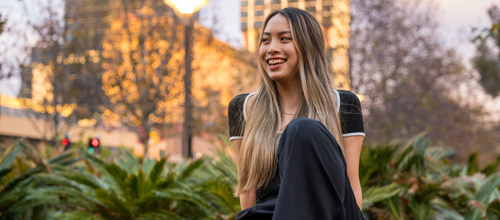Achievements and Announcements
ACHIEVEMENTS
- University scientists secure $7m for health and medical research
- Researchers win $3.6m to advance some of society’s big health challenges
- Trailblazing UniSA programs take out national awards
- $2.8m for nationally significant research projects
- UniSA shines in Australian Awards for University Teaching
- New Adelaide facility will fast track cancer treatment for children
- Champion of multiculturalism takes out top SA Governor award
- FII wounds researcher among NHMRC’s top health and medical scientists
- Major glass art prize for Gabriella Bisetto
- Rural health and aged care hub marks one year of hands-on impact
- Other recent award winners, grant recipients and expert appointments
ANNOUNCEMENTS
- Upload your photos, videos and other contributions to the UniSA Time Capsule
- UniSA law professor quoted in landmark High Court ruling
- UK link boosts AI and data science for Defence
- First Nations language celebrated at Kaurna Day with new songbook
- UniSA Sports Science Hub welcomes first student cohort to new, world-class facility
- Professor Craig Priest celebrates multiple milestones and 10 years at the helm
- UniSA contributes to landmark endometriosis inquiry
ACHIEVEMENTS
University scientists secure $7m for health and medical research
Identifying genetic links that predispose children to deadly brain cancers and neuroblastoma is the focus of a new Medical Research Future Fund (MRFF) project led by UniSA researchers.
The $976,292 project is one of five successful UniSA research projects, totalling more than $7 million, announced by the Federal Government in late March.
Chief Investigator Associate Professor Quenten Schwarz from the Centre for Cancer Biology says he hopes the $976,292 stem cell project will improve treatment outcomes for the two diseases that have a very low survival rate.
“Current treatment-induced side effects lead to long-term complications for children with these neuronal tumours, affecting their neurological and neurocognitive functions,” Assoc Prof Schwarz says.
“If we can better identify the genetic links to these diseases, it will inform new targeted treatment options for these cancers that are less toxic.”
Other UniSA chief investigators on the project include Professor Stuart Pitson, Dr Katherine Pillman, and Professor Natasha Harvey, along with researchers from SAHMRI, UNSW and the University of Western Australia.
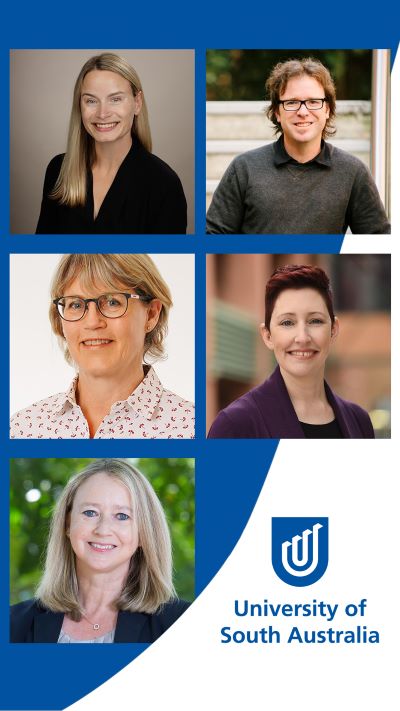
The other UniSA projects awarded MRFF funding are:
- Co-design models of care for youth with chronic pain ($2,604,235): MRFF EPCDRI & PHCR Multidisciplinary Models of Primary Care, Chief Investigators: UniSA’s Dr Carolyn Berryman, Prof Lorimer Moseley, Dr Hayley Leake, Prof Ian Gwilt, Dr Sarah Wallwork, Abby Jennings, and Prof Adrian Esterman. This project will develop an improved model of care for the 20% of youths in South Australia who experience chronic pain. This is a serious unmet need in Australia due to affected youths not being believed, leading to delayed diagnosis.
- Cost-effectiveness of a new treatment to reduce the risk of chronic post-surgical pain after total knee replacement surgery ($1,998,433): MRFF Preventive and Public Health Research Initiative, Chief Investigators: UniSA’s Assoc Prof Natasha Stanton, Prof Lorimer Moseley, Dr Daniel Harvie, Dr Felicity Braithwaite, Peter Ninnes, Dr Tyman Stanford). Total knee replacement surgery (TKR) is the gold standard care for knee osteoarthritis, with approximately 70,000 TKR surgeries performed each year. However, TKR causes long lasting severe pain for up to 15% of people undergoing surgery. This project will investigate a new lifestyle treatment approach so that people can rehabilitate with better outcomes.
- Medication safety rounds in aged care to prevent medication induced harm ($990,645): MRFF Dementia, Ageing and Aged Care Mission, Chief Investigators: UniSA’s Assoc Prof Janet Sluggett, Dr Sara Javanparast, Prof Marion Eckert, Prof Debra Rowett, Prof Ian Gwilt, Aaron Davis, Dr Daria Gutteridge. This study will equip pharmacists, nurses and aged care workers with the tools to identify medication issues early and develop safe action plans for aged care residents. New medication safety rounds will help address medication harm and management, which is the most common complaint reported to the Aged Care Quality and Safety Commission.
- Tailored hydrogels to improve wound healing therapy ($588,922): MRFF Stem Cells Therapies Mission, Chief Investigators: UniSA’s Prof Allison Cowin and Prof Ferry Melchels. Epidermolysis bullosa (EB) is a genetic skin condition affecting children and characterised by fragile skin, chronic blistering, open wounds, fibrosis, constant pain and early death. This project will develop an easy-to-apply stem-cell based WoundGel that stimulates healing without scarring and fibrosis.
The Medical Research Future Fund is a $22 billion long-term investment supporting Australian health and medical research. The MRFF aims to transform health and medical research and innovation to improve lives, build the economy and contribute to health system sustainability.
Researchers win $3.6m to advance some of society’s big health challenges
Two UniSA researchers have secured more than $3 million in National Health and Medical Research Council (NHMRC) Investigator grants to advance projects that are set to make a significant impact in society.
Investigator Grants provide the highest-performing researchers at all career stages with consolidated funding for their salary (if required) and a significant research support package.
Advancing the analysis of 24-hour time-use data ($1,323,700)
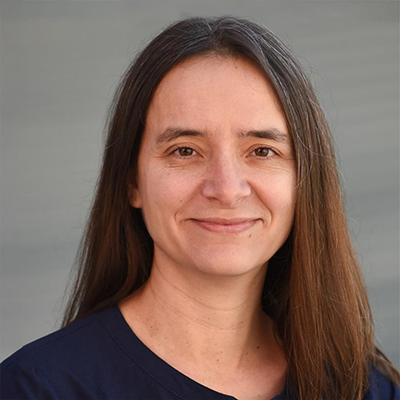
Professor in Behavioural Epidemiology Dot Dumuid is leading a project that will result in the creation of new methods to help researchers analyse how time spent in daily behaviours, such as physical activity, sedentary time or sleep, affects health and wellbeing.
The project will address gaps to inform the design and analysis of time-use interventions, providing answers to questions such as how many participants should be included in a study, how to determine feasible behaviour-change goals for individuals, and how to assess the impact of different behaviour change options on health and wellbeing.
Fetal growth restriction and cardiovascular-related death in adulthood: a world first in transforming detection and intervention ($2,354,575)
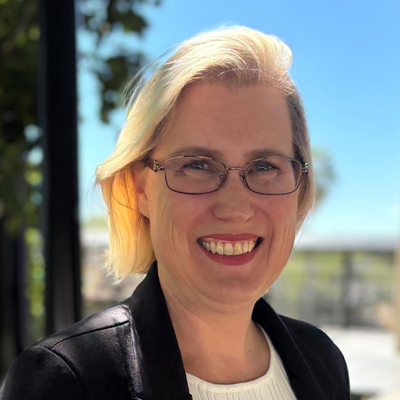
Professor of Physiology Janna Morrison is leading a project that aims to improve the ability to detect small babies before they are born, and also to discover how to intervene to improve their growth.
Every day, 80 Australian babies are born too small, increasing their risk of heart and other diseases later in life. By identifying these small babies before they are born and intervening to improve their growth, they can be set up with healthy hearts for life.
The funds are part of the NHMRC’s research grants for projects commencing in 2025.
Trailblazing UniSA programs take out national awards
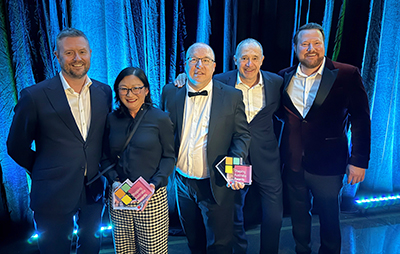 UniSA Vice Chancellor Professor David Lloyd, Professor Lan Snell, Associate Professor Stewart Von Itzstein, Dino Rossi and Ryan McClenaghan at the awards event in Canberra.
UniSA Vice Chancellor Professor David Lloyd, Professor Lan Snell, Associate Professor Stewart Von Itzstein, Dino Rossi and Ryan McClenaghan at the awards event in Canberra.UniSA’s two nominations in the 2024 national Shaping Australia Awards have taken out both of the prizes in their category.
The Shaping Australia Awards were established by Universities Australia to highlight the valuable contribution universities make to society.
Professor Tom Raimondo, Dr Jo Zucco and Associate Professor Stewart Von Itzstein won the Future Builder Award, as the team behind Australia’s first higher degree apprenticeship program, UniSA’s Bachelor of Software Engineering (Honours).
Professor Lan Snell, Professor Andrew Beer, Peter Stevens, Stan Astachnowicz, Sam Stengert, Leanne Steele, Ling Ly and Jodie Walsh, the team behind UniSA’s trailblazing Global Executive MBA in Defence and Space (GEMBA), took out the People’s Choice Award in the same category.
The Future Builder category honours initiatives that go above and beyond to deliver out-of-the-box teaching and industry engagement that bridges critical knowledge gaps. UniSA’s 2024 award wins reflect the University’s strengths in innovation and enterprise, and build on similar success in the inaugural awards last year.
Bachelor of Software Engineering (Honours)
UniSA’s Bachelor of Software Engineering (Honours) enables students to work full time at leading companies such as BAE Systems, while studying. This hands-on experience, combined with academic rigor, ensures they graduate as work-ready, experienced software engineers.
Created in partnership with industry partners including BAE and the AI Group, the success of the Bachelor of Software Engineering (Honours) has prompted the Department of State Development to issue a call for expressions of interest to establish additional degree apprenticeships in SA.
Global Executive MBA in Defence and Space (GEMBA)
UniSA’s Global Executive MBA in Defence and Space (GEMBA) is a unique 18-month program delivered across three countries, reflecting the trilateral nature of the AUKUS alliance. The program equips leaders with advanced skills in areas like cyber security, space systems and defence procurement, and combines immersive residentials in Australia, the UK and the US with high-quality online learning.
Through partnerships with Carnegie Mellon University, the University of Exeter and leading industry players, GEMBA empowers future leaders to navigate complex global security challenges and drive Australia’s defence and space industries forward.
Universities Australia CEO Luke Sheehy congratulated all the winners and finalists.
“These projects are changing lives, driving economic growth and securing Australia’s future. The overwhelming public response reflects the incredible contributions our universities make to help us all,” Sheehy says.
$2.8m for nationally significant research projects
UniSA researchers have been awarded about $2.8 million for seven projects to support nationally significant research and commercialisation projects.
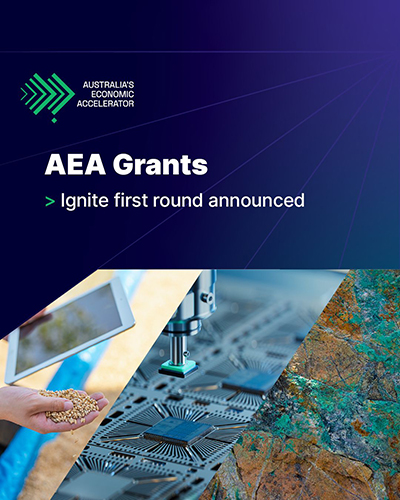
The grants were awarded by Australia’s Economic Accelerator, a $1.6 billion program taking a new approach to commercialising academic research. Known as the AEA Ignite grants, they’re designed to support early-stage research commercialisation through competitive grants of up to $500,000 for a maximum period of 12 months.
The inaugural grants will drive investment in key sectors, focusing on value-adding and capability development to leverage Australia’s natural and competitive strengths.
UniSA was awarded grants for the following projects:
- Development and preclinical validation of a laparoscopic magnetometer probe based on quantum sensors for intraoperative mapping of the spread of gastrointestinal tumours ($405,050), led by Future Industries Institute Research Fellow Dr Nicole Dmochowska
- Fluorescence fingerprint enabled high-density optical data storage ($354,900), led by Future Industries Institute Research Fellow Dr Wen Qi Zhang
- Realising Net Zero emissions – an affordable concentrated solar thermal (CST) demonstrator for industry and agriculture ($497,250), led by Future Industries Institute Senior Research Fellow Dr Marta Llusca Jane
- Future-proofing against resistant bacterial priority pathogens: innovative formulations to treat infections and save lives ($470,162), led by Research Fellow Dr May Song
- A robust chemical sensing platform for optimised process control in mineral processing operations ($192,339) led by Future Industries Institute Research Fellow Dr Bin Guan
- Advancing a digital tool for improved water decision-making in agriculture ($362,353), led by Associate Professor of Accounting Joanne Tingey-Holyoak
- A photonic rheometer for blood characterisation ($499,128), led by Associate Professor at Laser Physics and Photonic Devices Laboratories Shahraam Afshar.
UniSA also partnered on three successful applications led by other universities:
- A novel drug treatment for fibrotic disease (Monash University)
- Development of ResectAssist: a drug-eluting implantable device for the localised treatment of pancreatic cancer (University of Wollongong)
- Developing next-generation eutectic gels (e-gels) for on-demand front-line wound healing and infection control (RMIT University).
AEA grant projects must have a level of industry engagement and a pathway to commercialisation.
UniSA shines in Australian Awards for University Teaching
 2024 Australian Awards for University Teaching recipients
2024 Australian Awards for University Teaching recipientsMore than a dozen UniSA staff have been recognised as exceptional educators with an unwavering commitment to teaching and student experience.
The Australian Awards for University Teaching (AAUT) recognise exceptional contributions by university educators who demonstrate dedication to improving student learning outcomes and enhancing the higher education experience.
In a highly competitive national round, all six UniSA nominated teams won awards.
UniSA Associate Professor in Educational Sociology Dr Sarah Hattam and senior lecturer Tanya Weiler, both from UniSA Education Futures, were awarded a prestigious Teaching Excellence Award for developing and championing a teaching methodology that provides opportunities and a ‘second chance’ for those who have struggled in other educational systems. Known as Critical Enabling Pedagogy, the approach demands a holistic view of a student and is underpinned by a teaching philosophy of social justice where education is both a fundamental right and a form of empowerment for both social mobility and societal betterment. The award also recognised the pair’s work beyond their own classrooms at UniSA and nationally to include engagement across multiple universities, alongside a suite of online modules available worldwide.
UniSA also garnered an impressive array of Citations for Outstanding Contributions to Student Learning, highlighting individual dedication to enhancing the student experience:
- UniSA senior lecturer Dr Chelsea Cutting for innovatively embedding digital Responsive Micro Teaching to enhance online pre-service teachers' confidence in mathematics education;
- Professor of Environmental Science Delene Weber and lecturer Jayne Boase for their groundbreaking work in fire management education, fostering two-way learning and respect for Aboriginal knowledges;
- Senior lecturer in physiotherapy Dr Sophie Lefmann, who led a team of physiotherapy educators including tutor Dr Trish Neumann, adjunct senior lecturer Dr Rebekah Das, senior lecturer in pain science Dr Jane Chalmers, and lecturer Alison Bell; in pioneering innovative training for postgraduate physiotherapy students in pelvic organ prolapse pessary care;
- UniSA Online course facilitator Dr Paula Rowe for her leadership in developing online teaching approaches that support equity group students to build confidence and improve outcomes in human service courses;
- Pharmacy Practitioners in Residence Jimit Ghandhi and Kirsty LePoidevin were acknowledged with a Citation for Outstanding Contributions to Student Learning (Early Career Award) for developing immersive patient-centred placement experiences that empower pharmacy students in healthcare settings.
UniSA Provost and Chief Academic Officer Distinguished Professor Marnie Hughes-Warrington AO says the remarkable national awards highlight the exceptional quality and innovation in teaching across UniSA.
“Each recipient has made significant contributions that benefit not just our students, but the broader community,” Prof Hughes-Warrington says. “We congratulate all recipients on their well-deserved recognition.”
Read more about the award recipients in the awards booklet.
New Adelaide facility will fast track cancer treatment for children
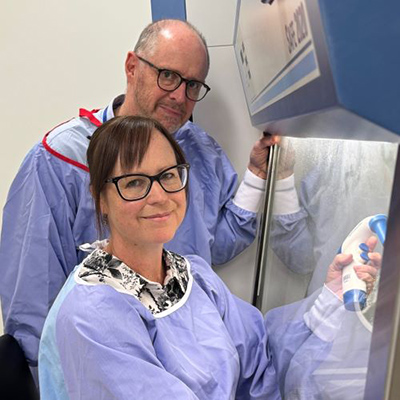 UniSA Professor Richard D'Andrea and Associate Professor Lisa Ebert in the new lab.
UniSA Professor Richard D'Andrea and Associate Professor Lisa Ebert in the new lab.A new tissue culture facility has opened at UniSA, helping to advance research into two of the most aggressive childhood cancers worldwide – brain tumours and acute myeloid leukemia (AML).
Approximately 120 children and adolescents are diagnosed with brain cancer each year in Australia, making it the second most common cancer in children after leukemia. The prognosis for children under five is brutal, with 45% not surviving their disease.
AML accounts for about 20% of childhood leukemia cases, affecting about 50 new children each year. The survival rate is higher – around 70% – but there is also a high rate of relapse and the existing treatment options leave long lasting effects.
Researchers from the Centre for Cancer Biology (CCB) – an alliance between SA Pathology and UniSA – have welcomed a $36,100 grant from Cops for Kids to help transform an unused space in UniSA’s flagship health research precinct into a much-needed tissue culture facility.
CCB Professor of Leukemia Biology Richard D’Andrea says the facility will be an invaluable resource for childhood cancer researchers located in the Bradley Building on North Terrace in the health and biomedical precinct.
“Cellular immunotherapy is an emerging field in childhood cancer treatment and the research to develop and optimise this involves tissue culture to grow and study cells in a specialised laboratory space under sterile conditions,” Prof D’Andrea says.
Immunotherapy – using the patient’s own immune cells to fight cancer – is now considered the fourth pillar of cancer treatment alongside surgery, radiotherapy and chemotherapy.
Prof D’Andrea says children with AML who are treated with intensive chemotherapy suffer many long-term implications due to the toxic effects of treatment.
“For some, this aggressive treatment does not provide a cure, so better treatments are badly needed to improve outcomes for these children.
“With a cellular immunotherapy approach, immune cells obtained from a patient or from a cord blood source can be engineered or manipulated in the laboratory and used to eradicate the cancer cells, which is less toxic for the patient.”
Read more in the media release.
Champion of multiculturalism takes out top SA Governor award
One of UniSA’s most passionate advocates for Aboriginal communities and marginalised groups has won the 2024 SA Governor’s Multicultural Award for Outstanding Individual Achievement.
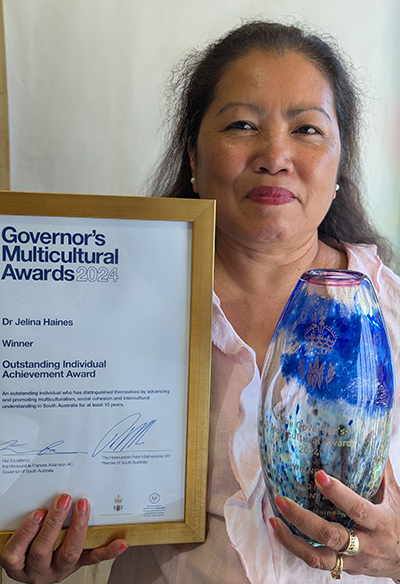 Dr Jelina Haines with her SA Governor's Multicultural Award.
Dr Jelina Haines with her SA Governor's Multicultural Award.Dr Jelina Haines, a practitioner-academic who has collaborated with Aboriginal Elders for more than 21 years and used art, storytelling and digital technologies to empower marginalised communities, was among nine winners and 31 finalists who attended the awards ceremony at Government House in early March.
The award, presented by the Governor of South Australia Frances Adamson AC, honoured Dr Haines’ extensive body of work over two decades, championing social cohesion, intercultural understanding and the revitalisation of Aboriginal arts.
A Filipino-born Australian with an ancestral link to Indigenous Americas-Mexico, Dr Haines migrated to South Australia in 1997. Since then, she has spearheaded 52 minor programs, five major projects, and three international educational initiatives.
Her work has provided crucial income opportunities for Aboriginal artists while fostering a strong sense of identity within communities.
One of her most notable artistic collaborations has been with the Ngarrindjeri Cultural Weavers at Camp Coorong. Through this mutual partnership, she has helped create intricate woven sculptures representing Ngarrindjeri totems, including a life-sized whale exhibited at the SA Museum and the Le Havre Museum in France.
Other remarkable pieces, such as the Pelican and Murray Cod sculptures, have found homes in the National Australia Gallery, the SA Maritime Museum, and Ngarrindjeri Totems at the Department of Infrastructure, and Uniting Communities. These projects have not only united Aboriginal families and storytelling traditions but have also reinforced deep connections to ancestral landscapes.
Beyond her artistic contributions, Dr Haines has made an international impact through her research on the impact of digital technologies on marginalised communities, particularly Aboriginal groups.
Read more in the media release.
FII wounds researcher among NHMRC’s top health and medical scientists
UniSA chronic wounds researcher Professor Allison Cowin is among an elite group of Australia’s health and medical scientists selected to appear in this year’s National Health and Medical Research Council (NHMRC) flagship publication: 10 of the Best.
The Future Industries Institute researcher is pioneering new approaches to wound repair, using innovative stem cell and antibody treatments to improve health outcomes for millions of people worldwide.
Describing wounds as “a spiralling epidemic affecting millions of people worldwide”, Prof Cowin and her team have developed a new diagnostic blood biomarker test and two new treatment approaches, using stem cells and targeted antibodies.
They have progressed a stem cell coated dressing, Cypatch, through preclinical laboratory studies and into phase I/II clinical trials with industry partners, TekCyte and Cynata Therapeutics. The results show active healing and Cynata have licensed the technology for further clinical trials and product development.
“For patients, this means reduced pain and infection phase,” Prof Cowin says. “It’s usually very difficult to get a wound to heal once it’s entered the chronic non-healing.
“Chronic wounds are an under recognised issue in Australian health care. For individuals with diabetes, the elderly, or those suffering from severe burns, there can be lifelong problems with healing.”
In another area close to her heart, Prof Cowin has worked for 15 years on Epidermolysis Bullosa (EB), a rare disease also known as ‘fragile skin’. She has created a new antibody treatment that improves healing and addresses internal blistering, a common issue for children with EB.
The next step is to progress the antibody to huma clinical trials.
Major glass art prize for Gabriella Bisetto
UniSA senior lecturer in Contemporary Art Gabriella Bisetto has won time the highly regarded Tom Malone Prize for the second time.
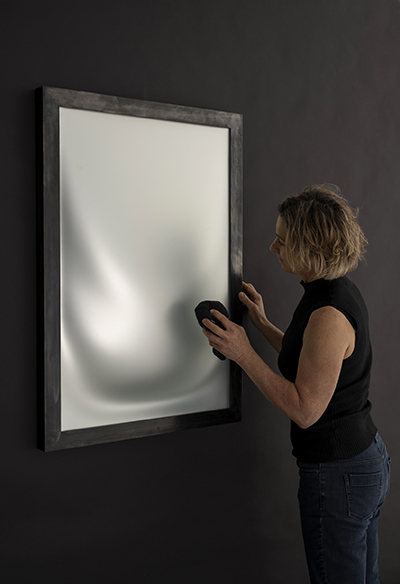 Gabriella Bisetto with This Skin I’m In #2. Photo by Michael Haines.
Gabriella Bisetto with This Skin I’m In #2. Photo by Michael Haines.Valued at $20,000, Gabriella’s glass artwork This Skin I’m In 2# was initially shortlisted out of a nationally competitive field by a peer review panel and then selected for the major prize by a panel of international and national judges.
The Tom Malone Prize is one of Australia’s largest awards for glass art with the winning work becoming part of the permanent collection of the Art Gallery of Western Australia.
Bisetto’s work was made in response to an invitation in 2024 from UniSA and JamFactory to present a solo exhibition and publication of her work which was shown in November 2024.
This is the second time Bisetto has won this prestigious award with the first time being in 2016 with the glasswork ‘becoming’ which was made for the exhibition Translucent Shadows at the SASA Gallery.
Bisetto says the JamFactory exhibition last year was a significant career opportunity amde possible because of the partnership between JamFactory and UniSA.
“Having time and the invitation to have a solo show last year has enabled me to reinvigorate my international reputation as a glass artist and allowed me to demonstrate to our students and the broader community what contemporary glass practice looks like,” she says.
Rural health and aged care hub marks one year of hands-on impact
A purpose-built health and aged care education centre in Port Lincoln is redefining aged care training in regional South Australia and celebrating its first anniversary.
From critical medicines to lifestyle essentials, UniSA’s Rural Health and Aged Care Education Centre was developed in partnership with Matthew Flinders Home (MFH).
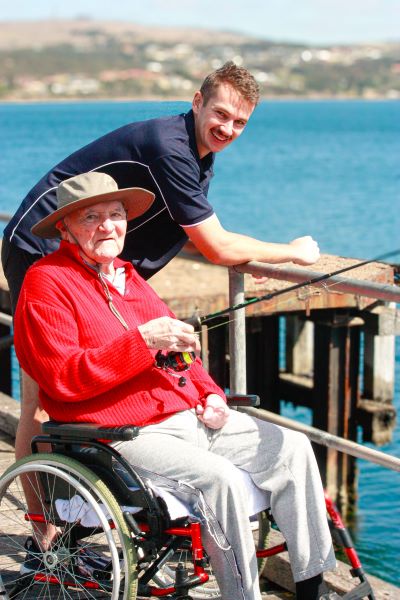 A Rural Health and Aged Care Education Centre student with a resident from MFH.
A Rural Health and Aged Care Education Centre student with a resident from MFH.The centre delivers high-quality, client-centred care while offering immersive training for UniSA’s nursing and allied health students. The centre has just celebrated its first anniversary.
Funded by the Commonwealth Government, the facility blends aged care and education, engaging students and local practitioners in real-world experiences across multiple disciplines including nursing, physiotherapy, occupational therapy, speech pathology, social work and pharmacy.
In just 12 months, the centre has recorded:
- 500+ supervised student-client interactions
- 43 individual student placements totalling 287 weeks of training
- A full calendar of education and development activities for students and MFH staff.
Standout training programs have included a fishing group for older adults, balance and falls prevention classes, food compliance audits, a dementia pain resource for staff, medication reviews, and clinical skills development in catheterisation and wound care.
By embedding students in aged care settings, the centre boosts the likelihood they’ll return to work in rural health after graduating – supporting the future of regional care in South Australia.
Other recent award winners, grant recipients and expert appointments
Other recent award winners and grant recipients from UniSA include:
- Three UniSA students have been awarded scholarships – collectively worth more than $100,000 – by the Australian Academy of Technological Sciences and Engineering (ATSE) as part of the Elevate: Boosting diversity in STEM program. The program aims to address inequities in science, technology, engineering and mathematics (STEM) by enabling more diverse women and non-binary people to access tertiary education, professional skills development and STEM leadership opportunities with industry and academia. UniSA PhD candidate Louise Hosking was awarded a 2025 Postgraduate Research Top-up Scholarship (worth $50,010 over 3.5 years) while Victoria Claire Polidano and Erin Crowe were awarded 2025 Undergraduate Scholarships (worth $30,000 over 3 years).
- PhD candidate and UniSA research assistant Jess de la Perrelle is one of 10 Australian early-career researchers to attend the 2025 Lindau Nobel Laureate Meeting in Germany. Read more in the Australian Academy of Science media release.
ANNOUNCEMENTS
Upload your photos, videos and other contributions to the UniSA Time Capsule
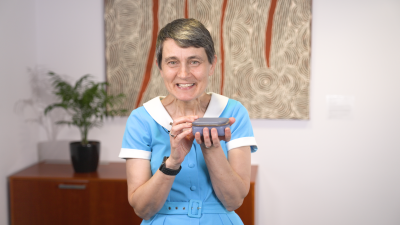 UniSA Provost and Chief Academic Officer Distinguished Professor Marnie Hughes-Warrington AO talks about her collection of UniSA-related pins in a video that is now part of the UniSA Time Capsule.
UniSA Provost and Chief Academic Officer Distinguished Professor Marnie Hughes-Warrington AO talks about her collection of UniSA-related pins in a video that is now part of the UniSA Time Capsule.Filled with curated photos, memorabilia, curios and artifacts from the 34 years of UniSA, and those institutions that came before, the UniSA Time Capsule is a digital collection celebrating UniSA’s achievements, history and culture across the sweep of its teaching, learning, research, community activity and campus life.
UniSA Provost and Chief Academic Officer Distinguished Professor Marnie Hughes-Warrington AO says the entire UniSA community is welcome to share digital memories and experiences at UniSA, or its antecedent institutions.
“We encourage you to spread the word and upload moments that are important to you,” Prof Hughes-Warrington says. “Remember, the Time Capsule is not a formal history of the University; this is a people’s history.”
The Proppa Stories component of the project is an opportunity to acknowledge and celebrate Aboriginal and Torres Strait Islander peoples’ contributions to UniSA.
“The best history is the one that we all make together. We encourage everyone to join our community in celebrating achievements, acknowledging milestones, and reflecting on more challenging times,” Prof Warrington-Hughes says.
“Don’t forget to vote for your favourite moments and share on your socials.”
The UniSA Time Capsule is now live on a dedicated website.
UniSA law professor quoted in landmark High Court ruling
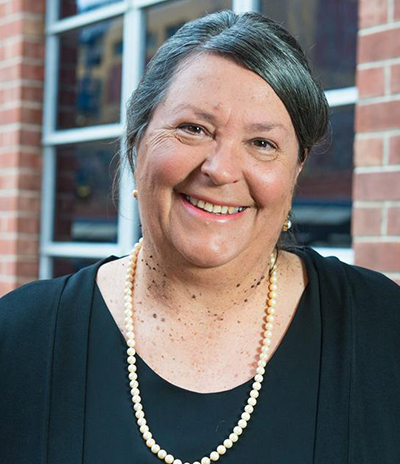
A recent landmark High Court ruling, clearing the way for a $700 million compensation claim lodged by the Gumatj people of the Northern Territory, signals an important shift in native title law in Australia, according to UniSA Distinguished Research Professor In Law, Irene Watson.
Prof Watson, who was the first Aboriginal person appointed to a Pro Vice Chancellor position at UniSA (Aboriginal Leadership and Strategy 2016-2023), says “the question of compensation for native title land and extinguishment of those rights is no longer a closed matter”.
On 12 March, the High Court upheld an earlier Federal Court ruling that a site in northeast Arnhem Land was acquired in the 1960s for bauxite mining through “unjust terms”. The late Aboriginal leader Dr Yunupingu filed the case on behalf of the Gumatj people in 2019.
The Crown authorised mining in the area without the Gumatj Clan’s consent.
The win confirms that native title is protected by Australia’s Constitution and the extinguishment of native title requires “just compensation”.
In handing down the ruling in the Commonwealth of Australia v Yunupingu case, High Court Justice James Edelman AC quoted a paragraph from Professor Watson’s 1996 paper, Law and Indigenous Peoples: the impact of colonialism on Indigenous culture.
“Using Anglo-Australian law to decide [the content of] the rights of Indigenous people … is the same as using Aboriginal law to decide [the content of] the rights of non-Indigenous Australians.”
Prof Watson says the “fullness of this right to compensation for both the Gumatj and other native title holders living beyond the Northern Territory and the ACT, will be resolved in years to come”.
“There is now an indication of a small shift; here’s hoping for more,” she says.
UK link boosts AI and data science for Defence
 Representatives from UniSA, the Defence Science and Technology Group (DSTG) and the Alan Turing Institute sign a Memorandum of Understanding to further research and development in AI and data science. Pictured: UniSA director for Defence & Space Ryan McClenaghan, Standing Acting Vice Chancellor Distinguished Professor Marnie Hughes-Warrington AO, Defence SA chief executive Matt Opie, DSTG chief of Information Sciences Division Suneel Randhawa, DAIRNet senior manager Dr Mel McDowall, UniSA Deputy Vice Chancellor: Research and Enterprise Professor Peter Murphy and director of the Centre for Emerging Technology and Security at the Alan Turing Institute Dr Sacha Babuta.
Representatives from UniSA, the Defence Science and Technology Group (DSTG) and the Alan Turing Institute sign a Memorandum of Understanding to further research and development in AI and data science. Pictured: UniSA director for Defence & Space Ryan McClenaghan, Standing Acting Vice Chancellor Distinguished Professor Marnie Hughes-Warrington AO, Defence SA chief executive Matt Opie, DSTG chief of Information Sciences Division Suneel Randhawa, DAIRNet senior manager Dr Mel McDowall, UniSA Deputy Vice Chancellor: Research and Enterprise Professor Peter Murphy and director of the Centre for Emerging Technology and Security at the Alan Turing Institute Dr Sacha Babuta.The Department of Defence has signed a new agreement with UniSA and the Alan Turing Institute, based in the United Kingdom, to tap into world-class expertise and research in artificial intelligence (AI) and data science.
A Memorandum of Understanding (MOU) was signed between the three organisations.
This MOU will strengthen strategic collaboration through information sharing in areas of high impact, including autonomous systems, cyber defence and natural language processing.
Chief Defence Scientist Professor Tanya Monro says the agreement demonstrates the integral role of academic and international partners in capability development for Defence.
“Through partnerships, we deliver scientific advice and technology solutions that unlock and enhance critical capability for Defence and the national security community,” Professor Monro says.
“Collaborating internationally is also essential to enabling Defence to access a greater range of innovative science and technology expertise, infrastructure and technical data to help address mutual problems.”
UniSA Deputy Vice Chancellor Research and Enterprise Professor Peter Murphy says the new collaboration highlights the University’s ongoing support of a collaborative and co-design approach to research.
“The formalisation of this partnership will enable cutting-edge research to ensure AI innovations are developed and applied responsibly, addressing challenges across Australia and the UK,” Prof Murphy says.
The Alan Turing Institute is the UK’s national institute for data science and AI.
Director of the Centre for Emerging Technology and Security at the Alan Turing Institute, Dr Sacha Babuta, says global collaboration was essential to unlocking the full potential of emerging technologies for defence and security.
“Working with Australia’s world-class research institutions will help us to tackle shared challenges and, ultimately, help both nations harness new technologies to meet societal needs,” Dr Babuta says.
Read more in the Department of Defence’s news article.
First Nations language celebrated at Kaurna Day with new songbook
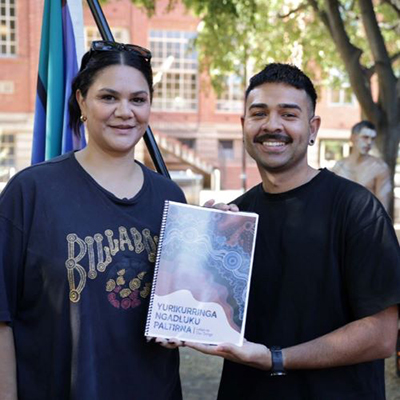 Kaurna songbook cover artist Gabriel Stengle and Project Officer at Kaurna Warra Pintyanthi Jaylon Newchurch. Photo by Andre Castellucci.
Kaurna songbook cover artist Gabriel Stengle and Project Officer at Kaurna Warra Pintyanthi Jaylon Newchurch. Photo by Andre Castellucci.The UniSA and the University of Adelaide communities have come together to celebrate the second annual Kaurna Day, this year marked by the launch of a Kaurna songbook — a valuable resource for preserving and revitalising the Kaurna language.
Titled Yurikurringa Ngadluku Paltirna: Listen to Our Songs, the Kaurna songbook is a contemporary reworking of the original Kaurna Paltinna, created in the 1990s.
Developed in collaboration with Kaurna Warra Pintyanthi (KWP), the Centre for Aboriginal Studies in Music (CASM), Kaurna Plains School, independent Aboriginal artists, and Kaurna community members, it contains 15 songs in Kaurna language or featuring Kaurna words. The songbook serves as both an educational tool and a cultural archive.
With 109 out of 123 spoken Indigenous languages in Australia listed as endangered, the urgency to safeguard language and cultural identity has never been greater. The Kaurna songbook aims to combat language decline among younger generations of Kaurna people, strengthening identity, resilience, and wellbeing within the community.
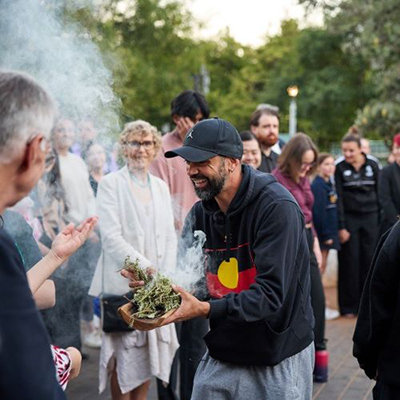 Photo by Andre Castellucci.
Photo by Andre Castellucci.Kaurna Day: Tirkanthi - Ngutu - Taikurrinthi (Learning - Knowledge - Be United Together) is a free public event honouring and celebrating First Nations people and culture where the new songbook further strengthens the commitment to culture preservation. Following the success of the University of Adelaide’s first Kaurna Day last year, this year’s event expands its celebration of music, dance and storytelling, by extending from the University of Adelaide’s North Terrace campus to Roseworthy, Waite, and UniSA’s City West Campus.
UniSA Pro Vice Chancellor: Aboriginal Leadership and Strategy Professor Tina Brodie says Kaurna Day is an opportunity to recognise the ongoing connection of the Kaurna People to their place and to celebrate Aboriginal Torres Strait Islander Cultures more broadly.
“The launch of the Kaurna songbook is a representation of the generosity of the Kaurna people and all Aboriginal and Torres Strait Islander Peoples’ who share knowledges and culture with us all,” Prof Brodie says.
Read more in the media release.
UniSA Sports Science Hub welcomes first student cohort to new, world-class facility
A multi-million-dollar sports complex, 15 years in the planning, has opened its doors to its first cohort of university students ready to engage in its world-class teaching and research facilities at South Australia’s new sports precinct.
Created in partnership with the South Australian Sports Institute (SASI) and the Office for Recreation, Sport and Racing, the UniSA Sports Science Hub is the only facility of its kind in the Southern Hemisphere, and only the second in the world.
The Hub is designed to deliver industry-embedded specialist sports science education, greater research opportunities, and cutting-edge solutions for industry, so that all students have authentic learning experiences, scope to engage with leading industry staff and elite athletes, and a career-ready education.
Its state-of-the-art facilities include a biomechanics lab; an environmental chamber that can simulate humidity, altitude and temperature extremes (from -11 to 45°C); physiology teaching laboratories; and an exercise research lab for high performance, intensive exercise research.
UniSA Executive Dean for Allied Health and Human Performance Professor Jon Buckley says the new Sports Science Hub will provide multiple benefits for students, researchers, SASI, and the State.
“UniSA and SASI have had a long-standing relationship for more than 20 years,” Prof Buckley says.
“The new UniSA Sports Science Hub solidifies this, bringing together our world-leading teaching and research capabilities in exercise and sports science, with SASI’s expertise in preparing high-performance athletes, to highlight a partnership that is truly unique.
“For our students, the new facilities will provide a genuine and authentic learning experience, where they’ll be able to interact with SASI staff and athletes as part of their learning, even undertaking analysis and training with data that’s being used by staff at SASI. So, they’ll get very industry-relevant training and exposure to the exercise and sports science sector before they graduate.”
Read more in the media release.
Professor Craig Priest celebrates multiple milestones and 10 years at the helm
A $10 million manufacturing treasure chest unveiled at UniSA in late 2023 – the Precision Engineering Centre (PEC) – is set to double in size this year, cementing its status as a world-class advanced optics facility.

The expansion of the PEC, situated within the SA node of the Australian National Fabrication Facility (ANFF-SA) at the Future Industries Institute, coincides with the tenth year of Professor Craig Priest at the helm.
Under his decade of leadership, the ANFF-SA team has tripled in size and its footprint has expanded across UniSA and Flinders University to become one of Australia’s most significant micro and nano-fabrication facilities.
This year the PEC will house new ultra precision fabrication and metrology, supported by the Commonwealth and South Australian governments, UniSA and the DST Group.
Other strategic initiatives include ANFF-SA’s Microengineering Winter School, ANFF’s first apprentice, numerous examples of first-in-Australia equipment, and major industry and academic partnerships.
UniSA Deputy Vice Chancellor Research and Enterprise Professor Peter Murphy says Prof Priest’s leadership had seen a multi-million-dollar investment in world-class infrastructure in South Australia.
“This has enabled us to engage with local, national and international industry partners in areas as diverse as space, defence, health, energy and the environment,” Prof Murphy says.
ANFF CEO Jane Fitzpatrick also paid tribute to Prof Priest’s leadership, thanking him for his outstanding service to clients and the impressive network of researchers he has connected in the past decade.
Prof Priest says leading ANFF-SA had been “a remarkable privilege”.
“Our people, facilities and partners are all world class, and the research we enable is changing people’s lives. Even today we are pursuing a vision to reach new heights in the decades to come.”
Prof Priest’s commitment to industry-informed education and engagement was recognised recently, with his selection as a finalist in the 2024 SA Science Excellence Awards.
Learn more about the ANFF-SA’s work in this video: Nano-scale devices for fluid sensing, Prof Craig Priest.
UniSA contributes to landmark endometriosis inquiry
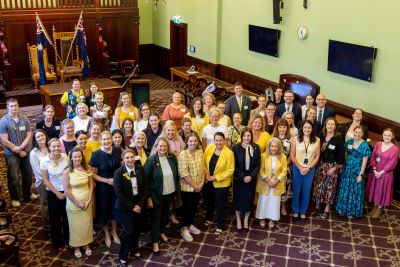 United in yellow for endometriosis awareness – advocates and inquiry participants gather at the State Parliament.
United in yellow for endometriosis awareness – advocates and inquiry participants gather at the State Parliament.UniSA staff and researchers have contributed to the State’s landmark inquiry into the debilitating impact of endometriosis and how to improve treatments and supports.
Dr Jane Chalmers, Professor Nayana Parange, Alison Deslandes and Shae Maple have provided expert statements to the SA Parliamentary Select Committee on Endometriosis with their insights and advice helping shape the Final Report.
About one in seven South Australian women and people with a uterus will experience endometriosis, which causes body tissue similar to the lining of the uterus to grow in other parts of the body. It causes severe pain, infertility, and can significantly affect a person’s quality of life.
Their contributions hope to increase awareness of the chronic inflammatory condition, as well as access to timely and effective treatments.
The full report and recommendations are available ion the SA Parliament website.
Other Stories
- Happy job, happy life? Works both ways, new research shows
- UniSA-Calvary Hospital surgical escape room puts nurses to the test
- The Conversation: Why do plastic containers always come out wet from the dishwasher? Science has the answer
- From the Vice Chancellor: Grab your towel and don’t panic
- Achievements and Announcements
- Whyalla campus honours Nancy Cooper at launch of new social work studio
- In Pictures: International Women’s Day lunch
- The latest books from UniSA researchers


